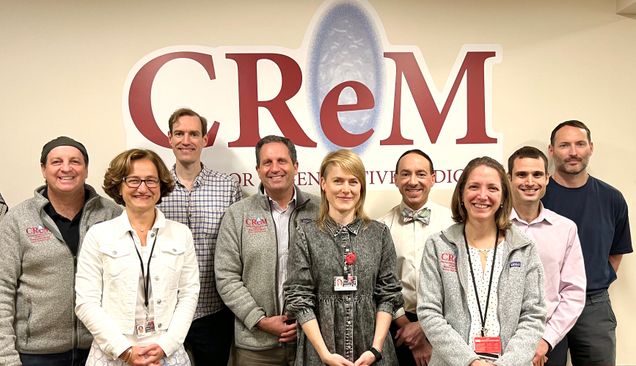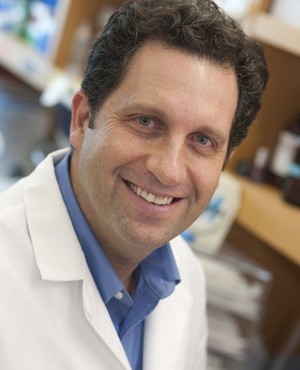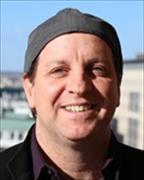CReM Celebrates 10th Anniversary as Pioneering Center for Stem Cell Research
 CReM principal investigators (l-r) Gustavo Mostoslavsky, Valerie Gouon-Evans, Andrew Wilson, Darrell Kotton, Kim Vanuytsel, George Murphy, Angie Serrano, Kostas Alysandratos and Finn Hawkins.
CReM principal investigators (l-r) Gustavo Mostoslavsky, Valerie Gouon-Evans, Andrew Wilson, Darrell Kotton, Kim Vanuytsel, George Murphy, Angie Serrano, Kostas Alysandratos and Finn Hawkins.
Professor of Medicine Gustavo Mostoslavsky, MD, PhD, recalled fellow Argentinian scientist and Nobel Prize winner Cesar Milstein telling him that as young scientist you are presented with a ball full of knots and that you keep untying them, one knot at a time, and, maybe, 20 years later you might have a major discovery.
In the decade since the Center for Regenerative Medicine (CReM) of Boston University and Boston Medical Center (BMC) was established by co-founders Mostoslavsky, Professor of Medicine Darrell Kotton, MD, and Associate Professor of Medicine George Murphy, PhD, there has been a lot of untying of knots on some of the world’s most intractable diseases.

“We have a slogan that reflects our mission – ‘Advancing Science to Heal the World,’” said Kotton. “And we’ve tried to pursue that in the most selfless way possible.”
Regenerative medicine uses stem cells and the body’s natural healing process to replace or rebuild damaged tissues and organs. Until Japanese scientist Shinya Yamanaka, MD, PhD, discovered a way to make induced pluripotent stem cells (iPSCs) from mouse fibroblasts in 2006 and then from human fibroblasts in 2007, research had been restricted by political and ethical debates over using pluripotent stem cells from human embryos. iPSCs are cells engineered from adults that are nearly identical to embryonic stem cells (ESCs). Once engineered in the laboratory in the undifferentiated state, like ESCs, iPSCs are pluripotent – meaning they have many potentials. Once differentiated iPSCs can be used to build specific tissues and organs, mimicking the embryonic tissue-building process.
“The stem cell field really took off with the discovery of reprogramming, of how to generate these pluripotent stem cells from anyone, especially patients,” said Kotton.
CReM first launched in 2008 as a virtual center with a seminar series and a website. Within a few years, Kotton, Mostoslavsky and Murphy were able to gain the support of Kate Walsh, then President and CEO of Boston Medical Center (BMC), former BU President Robert Brown, medical school Dean Karen Antman, MD, and David Coleman, MD, then chief and chair of the department of medicine, now professor emeritus of medicine. The virtual center was also supported by Katya Ravid, PhD, when the group received the inaugural Affinity Research Collaborative (ARC) award given out by Ravid’s then new Evans Center for Interdisciplinary Biomedical Research.
The CReM became a physical center when it opened its doors in 2013 with support from BU and BMC and its lab space has since grown from around 7,000 to 16,000 square feet, from one culture room to five, and from 25 researchers in six labs to 66 working in nine labs. The group’s high impact publications have resulted in yearly accolades from a variety of campus and national organizations and an impressive 300% growth in grant dollars.
Kotton separates the center’s progress over the past decade into three phases. In the early years, CReM made significant progress in reprogramming cells from patients, making iPSCs that duplicate cells or tissues needed for damage repair. In the middle years, there were remarkable advances in using those stem cells to discover how tissues are encoded and differentiate to become specific organs and other parts of the body. More recently, CReM research advanced the science of engraftment, the transplanting of these engineered cells and organoids into damaged organs in animal models, successfully regenerating a variety of injured tissues.
“The transplanted cells rescue organ function, and they survive in some cases, for the lifetime of the recipient,” said Kotton.
The next phase is to move testing into larger animals and then into human clinical trials, with the goal of creating gene therapies using stem cells.
“I think anybody around the world would recognize that the CReM has made contributions in those three areas: reprogramming technology to make stem cells; directed differentiation to make really advanced organoids and cell types; and our progress towards cell and gene-based therapies,” said Kotton.
 One of the CReM’s first discoveries as a still virtual center was publication of a new reprogramming approach, led by Mostoslavsky, ultimately earning him the award for “BU Innovator of the Year” in 2017. iPSC generation was a time-consuming and expensive process until Mostoslavsky developed a tool called STEMCCA that made it simpler and more efficient. BU patented the tool, and it was freely shared and used in over 1,000 labs worldwide.
One of the CReM’s first discoveries as a still virtual center was publication of a new reprogramming approach, led by Mostoslavsky, ultimately earning him the award for “BU Innovator of the Year” in 2017. iPSC generation was a time-consuming and expensive process until Mostoslavsky developed a tool called STEMCCA that made it simpler and more efficient. BU patented the tool, and it was freely shared and used in over 1,000 labs worldwide.
“In the last 10 years, we have become much, much better at making cells that are closer to what they are supposed to look like,” said Mostoslavsky. He’s hoping that the future brings advancements in cell and tissue manufacturing that will enable them to build whole, functioning organs.
But as current researchers, students and alumni of the program gather at Mostoslavsky’s home this weekend to mark CReM’s 10th anniversary, it is not just the untying of scientific knots they will be celebrating.
“Many famous centers have big discoveries, but I think, in addition to the scientific discoveries, what is unique about the CReM is the track record of selfless sharing,” said Kotton, who was named the inaugural recipient of the AAMC’s National Research Resource Sharing Award (2017) in recognition of the CReM’s record of sharing their stem cells.
Kotton, Mostoslavsky and Murphy came to BU because of its culture of collaborative research. They decided from the outset that the center would follow the open-source sharing model that had emerged in the computer code-writing culture. They created biobanks that housed stem cells and organoids and made them freely available upon request. They are one of the largest repositories of iPSC samples for various diseases in the world.
“It’s 100% that people know us and recognize us as the guys that collaborate and share,” said Mostoslavsky. This sharing and collaborative principle was something that the world came to realize as an important principle in the desperate race to develop tests and find vaccines to fight the COVID-19 pandemic.
“There was a lot of cultural dogma at the time (CReM was founded) that you have to protect your research until you publish because you are in competition with others and are going to get scooped,” said Kotton. “The collaborative approach is more efficient and faster, with shared research across the globe. For us it’s been an even more positive and productive experience than we planned at the beginning.”
Today, the CReM includes nine principal investigators covering different aspects of developmental biology, stem cell biology and regenerative medicine. Associate Professor of Medicine Andrew Wilson, MD, who was recently named scientific director of the Alpha-1 Foundation, runs both a research program in the CReM and an internationally recognized clinical center at BMC focused on caring for patients affected by alpha-1 antitrypsin deficiency, the most common genetic cause of chronic obstructive pulmonary disease. Assistant Professor of Medicine Finn Hawkins, MBBCh, uses iPSCs to develop new therapies for genetic airway diseases, such as cystic fibrosis.
CReM co-founder Murphy, who originally established studies in the field of sickle cell anemia, is now part of a team studying supercentenarians and understanding aging and extreme longevity. Valerie Gouon-Evans, PhD, MS, PharmD, directs the BU Liver Biology Program, focused on developing approaches for liver regeneration. Angie Serrano, PhD, assistant professor of medicine, joined CReM in 2022, studying iPSCs and how various mutations impact cell fates in a variety of diseases.
The two newest additions, Kim Vanuytsel, PhD, MS, and Kostas Alysandratos, MD, PhD, research treatments for sickle cell disease and interstitial lung diseases, respectively. Together with Mostoslavsky, who works on understanding neurodegeneration, intestinal organoids and T cells, and Kotton who studies lung injury and repair, these faculty lead the nine research programs of this multi-disciplinary center, advancing the field of stem cell biology and regenerative medicine.
View all posts